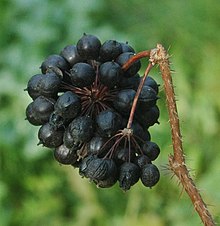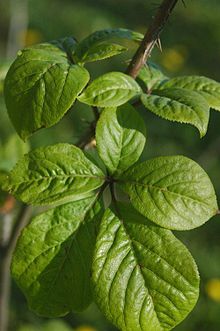| Revision as of 08:06, 8 June 2018 editCitation bot (talk | contribs)Bots5,435,861 editsm Removed parameters. You can use this bot yourself. Report bugs here.← Previous edit | Revision as of 23:06, 11 July 2018 edit undo2600:1700:6370:6380:6a94:23ff:fef5:acd7 (talk) →Traditional medicine and adverse effectsNext edit → | ||
| Line 37: | Line 37: | ||
| == Traditional medicine and adverse effects== | == Traditional medicine and adverse effects== | ||
| Extracts from the root of ''Eleutherococcus senticosus'' have a reputation in ] for providing health effects, but such claims are not supported by ].<ref name=who/><ref name=drugs/><ref name=acs>{{cite book |publisher=] |title=American Cancer Society Complete Guide to Complementary and Alternative Cancer Therapies |edition=2nd |year=2009 |isbn=9780944235713 |editor=Ades TB |pages=337–339 |chapter=Eleuthero}}</ref> The plant has been assessed in preliminary research for its potential use as an ] or antistress agent |
Extracts from the root of ''Eleutherococcus senticosus'' have a reputation in ] for providing health effects, but such claims are not supported by ].<ref name=who/><ref name=drugs/><ref name=acs>{{cite book |publisher=] |title=American Cancer Society Complete Guide to Complementary and Alternative Cancer Therapies |edition=2nd |year=2009 |isbn=9780944235713 |editor=Ades TB |pages=337–339 |chapter=Eleuthero}}</ref> The plant has been assessed in preliminary research for its potential use as an ] or antistress agent.<ref name=who/> | ||
| People with high blood pressure, ], ], ], mental illness, a compromised ], women during pregnancy and lactation, and people taking ] or ] may have adverse reactions to ''E. senticosus''.<ref name=drugs/><ref name=um/> High doses may cause irritability, confusion, ], or anxiety.<ref name=drugs/><ref name=um/> People taking ]s, ]s, ], or ] medications may experience ]s from taking ''E. senticosus'' supplements.<ref name=um/> ''E. senticosus'' may have adverse interactions with alcohol.<ref name=webmd/> The substance should not be given to children.<ref name=um/> | People with high blood pressure, ], ], ], mental illness, a compromised ], women during pregnancy and lactation, and people taking ] or ] may have adverse reactions to ''E. senticosus''.<ref name=drugs/><ref name=um/> High doses may cause irritability, confusion, ], or anxiety.<ref name=drugs/><ref name=um/> People taking ]s, ]s, ], or ] medications may experience ]s from taking ''E. senticosus'' supplements.<ref name=um/> ''E. senticosus'' may have adverse interactions with alcohol.<ref name=webmd/> The substance should not be given to children.<ref name=um/> | ||
Revision as of 23:06, 11 July 2018
| Eleutherococcus senticosus | |
|---|---|

| |
| Scientific classification | |
| Kingdom: | Plantae |
| (unranked): | Angiosperms |
| (unranked): | Eudicots |
| (unranked): | Asterids |
| Order: | Apiales |
| Family: | Araliaceae |
| Genus: | Eleutherococcus |
| Species: | E. senticosus |
| Binomial name | |
| Eleutherococcus senticosus (Rupr. & Maxim.) Maxim. | |
| Synonyms | |

Eleutherococcus senticosus is a species of small, woody shrub in the family Araliaceae native to Northeastern Asia. It may be colloquially called Siberian ginseng, eleuthero, ciwujia, Devil's shrub, shigoka, touch-me-not, wild pepper, or kan jang. E. senticosus has a history of use in folklore and traditional Chinese medicine. Root extracts of E. senticosus are sold as a dietary supplement or cosmetic, usually under the name Siberian ginseng.
Etymology
The scientific name, Eleutherococcus (from Greek) means "free-berried," and senticosus, (from Latin) means sentis (thorn-bush, briar), an adjective meaning "thorny" or "full of briers or thorns." It is not the same plant as American ginseng (Panax quinquefolius) or Asian ginseng (Panax ginseng). It has a diversity of common names across its range of distribution.
Distribution
The herb grows in mixed and coniferous mountain forests, forming low undergrowth or is found in groups in thickets and edges. Eleutherococcus senticosus is sometimes found in oak groves at the foot of cliffs, rarely in high forest riparian woodland. Its native habitat is East Asia, China, Japan, and Russia. E. senticosus is broadly tolerant of soils, growing in sandy, loamy, and heavy clay soils with acid, neutral, or alkaline chemistry and including soils of low nutritional value. It can tolerate sun or dappled shade and some degree of pollution. E. senticosus is a deciduous shrub growing to 2 metres (6.6 ft) at a slow rate. It is hardy to zone 3. It flowers in July in most habitats. The flowers are hermaphroditic and are pollinated by insects.
Extract and chemical constituents
Roots of E. senticosus are cylindrical, up to 0.5 centimetres (0.20 in) in diameter, straight or branched, dark brown, and have a smooth surface with bark fixed closely to the xylem. The derived extract from the roots has been characterized for its major constituents, including lignans, sesamin (eleutheroside B4), syringaresinol, phenylpropanes, coumarins, beta-sitosterol and daucosterol.
Berries from E. senticosus contain diverse polyphenols, including caffeic acid, vanillic acid, ferulic acid, p-coumaric acid, and benzoic acid, with significant content of calcium, magnesium, and potassium.
Major constituents of essential oil from leaves of Eleutherococcus senticosus include α-bisabolol (26%), β-caryophyllene (7%), germacrene D (7%), β-bisabolene (5%), and α-humulene (4%).
Traditional medicine and adverse effects
Extracts from the root of Eleutherococcus senticosus have a reputation in traditional medicine for providing health effects, but such claims are not supported by medical evidence. The plant has been assessed in preliminary research for its potential use as an antimicrobial or antistress agent.
People with high blood pressure, sleep apnea, narcolepsy, heart disease, mental illness, a compromised immune system, women during pregnancy and lactation, and people taking digoxin or hexobarbital may have adverse reactions to E. senticosus. High doses may cause irritability, confusion, insomnia, or anxiety. People taking anticoagulants, corticosteroids, lithium, or diabetes medications may experience adverse effects from taking E. senticosus supplements. E. senticosus may have adverse interactions with alcohol. The substance should not be given to children.
References
- ^ "Eleutherococcus senticosus (Rupr. & Maxim.) Maxim". U.S. National Plant Germplasm System. 13 March 2017. Retrieved 30 December 2017.
- "The Plant List: A Working List of All Plant Species".
- ^ "Radix Eleutherococci". Monographs on Selected Medicinal Plants, Volume 2, World Health Organization. Retrieved 30 December 2017.
- ^ "Eleutherococcus". Drugs.com. 2017. Retrieved 30 December 2017.
- ^ "Siberian ginseng". Complementary and Alternative Medicine Guide, University of Maryland Medical Center, Baltimore. 2017. Retrieved 30 December 2017.
- ^ "Siberian ginseng". WebMD. 2017. Retrieved 30 December 2017.
- "Eleutherococcus senticosus". Plants for a Future. Retrieved 2013-01-16.
- Załuski, D; Olech, M; Galanty, A; Verpoorte, R; Kuźniewski, R; Nowak, R; Bogucka-Kocka, A (2016). "Phytochemical Content and Pharma-Nutrition Study on Eleutherococcus senticosus Fruits Intractum". Oxidative Medicine and Cellular Longevity. 2016: 9270691. doi:10.1155/2016/9270691. PMC 5098108. PMID 27843534.
{{cite journal}}: CS1 maint: unflagged free DOI (link) - Zhai, C; Wang, M; Raman, V; Rehman, J U; Meng, Y; Zhao, J; Avula, B; Wang, Y H; Tian, Z; Khan, IA (2017). "Eleutherococcus senticosus (Araliaceae) Leaf Morpho-Anatomy, Essential Oil Composition, and Its Biological Activity Against Aedes aegypti (Diptera: Culicidae)". Journal of Medical Entomology. 54 (3): 658–669. doi:10.1093/jme/tjw221. PMID 28399215.
- Ades TB, ed. (2009). "Eleuthero". American Cancer Society Complete Guide to Complementary and Alternative Cancer Therapies (2nd ed.). American Cancer Society. pp. 337–339. ISBN 9780944235713.
External links
| Psychostimulants, agents used for ADHD, and nootropics (N06B) | |||||||||
|---|---|---|---|---|---|---|---|---|---|
| N06BA Centrally acting sympathomimetics | |||||||||
| N06BC Xanthine derivatives | |||||||||
| N06BX Other psychostimulants and nootropics | |||||||||
| |||||||||
| Taxon identifiers | |
|---|---|
| Eleutherococcus senticosus |
|
| Hedera senticosa | |